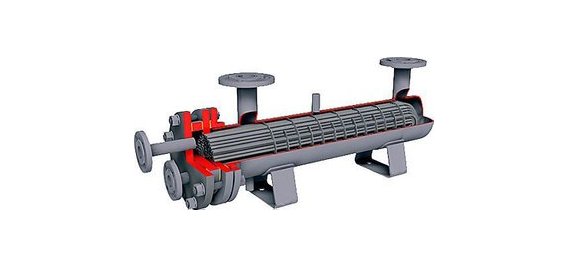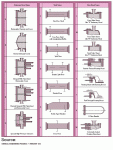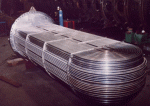Chemical and Process Engineering Resources

TEMA Designations for Liquid-Liquid Shell and Tube Exchangers
Shell and tube heat exchangers are available in a wide range of configurations as defined by the Tubular Exchanger Manufacturers Association (TEMA, www.tema.org). In essence, a shell and tube exchanger is a pressure vessel with many tubes inside of it. One process fluids flows through the tubes of the exchanger while the other flows outside of the tubes within the shell. The tube side and shell side fluids are separated by a tube sheet.
Each shell and tube exchanger is designated by a three (3) letter code. The letters refer to the specific type of stationary head at the front, the shell type, and rear head type. Fixed tube sheet style exchangers with TEMA designations of BEM, AEM, or NEN are fairly common for liquid-liquid heat transfer duties. While fixed head arrangements have the advantage of being inexpensive and avoiding gaskets or packing to contain the shell side fluid, they do not allow for mechanical cleaning of the shell side.
For liquid-liquid heat transfer duties where the ability to mechanically clean the shell side as well as the tube side is a requirement, a floating head design should be chosen. With a floating head design, the tube bundle can be pulled out of the shell to allow access to the shell side. Some of the most commonly used floating head designs for liquid-liquid duties include AES and BES. Another advantage of the floating head design is the ability to accommodate larger temperature differentials between the hot side and cold side fluids.
 |
| Figure 6: TEMA Designations for Shell and Tube Heat Exchangers |
 |
| Figure 7: Photo of a U-tube Bundle |
All of the designations discussed so far (BEM, AEM, NEN, AES, and BES) allow for multiple tube passes which are usually required for liquid-liquid duties so that the tube side velocities can be manipulated during the design stage of the exchanger.
The final type of shell and tube exchanger commonly used for liquid-liquid duties is commonly referred to as the "U-tube"Â type. Common TEMA designations are BEU and AEU. In this arrangement the tubes are bent into a series of concentrically tighter U-shapes with the end of the tubes being attached to the tube sheet.
The U-tube bundle can be removed to access the shell side for mechanical cleaning. The U-tube design is preferred for services with temperature or pressure cycling, intermittent service, and when there is a large temperature differential between the shell side and tube side fluids.
Since the "U"Â bend of the tubes cannot be accessed for mechanical cleaning, the tube side fluid should be clean or a suitable chemical cleaning agent should be identified.

 FB
FB


1 Comments
what happens if temperature cross occurs in heat exchanger?